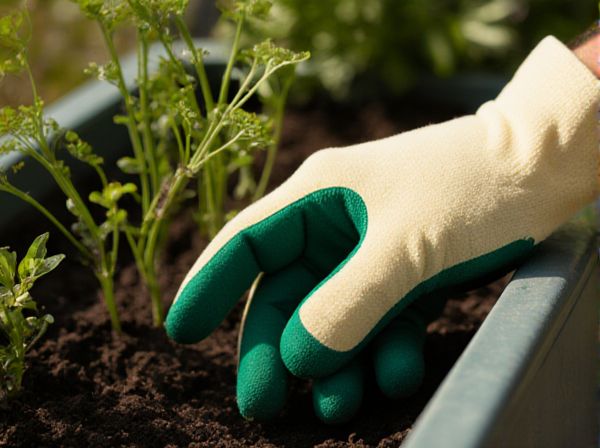
Container Shade Gardening vs In-ground Shade Gardening Illustration
Container shade gardening offers flexibility in plant placement and easier control over soil quality and moisture levels compared to in-ground shade gardening. In-ground shade gardening benefits from natural soil ecosystems, providing deeper root growth and better insulation for plants. Both methods require selecting shade-tolerant plants but differ in maintenance intensity and adaptability to changing environments.
Table of Comparison
| Aspect | Container Shade Gardening | In-ground Shade Gardening |
|---|---|---|
| Location Flexibility | Highly flexible; pots can be moved to optimize shade or sunlight. | Fixed; plants remain rooted in one location. |
| Soil Control | Full control over soil type and quality. | Limited; dependent on native soil conditions. |
| Water Management | Easier to regulate; containers retain or drain water efficiently. | Depends on garden drainage and soil absorption. |
| Pest and Disease Control | Lower risk; isolated growing environment. | Higher risk; open to surrounding pests and diseases. |
| Plant Variety Suitability | Supports shade-tolerant plants with specific soil needs. | Ideal for shade plants adapted to local soil and climate. |
| Maintenance | Requires frequent watering and monitoring. | Varies; generally less frequent but depends on soil conditions. |
| Space Efficiency | Ideal for limited space like balconies or patios. | Requires garden space; less suited for small areas. |
Overview of Container Shade Gardening vs In-ground Shade Gardening
Container shade gardening offers flexibility with movable pots that accommodate plants requiring low light, ideal for patios or small spaces. In-ground shade gardening involves planting directly in shaded soil areas, providing deeper root access and better moisture retention. Both methods support shade-loving species but differ in maintenance ease and spatial adaptability.
Choosing the Right Plants for Shade in Containers and Ground Beds
Selecting plants for container shade gardening requires species that thrive in confined root zones and reduced light, such as ferns, hostas, and caladiums. In-ground shade gardening allows for broader root expansion, favoring shade-tolerant shrubs, groundcovers, and shade-loving perennials like astilbes and heucheras. Matching plant root space adaptability and light requirements ensures thriving growth in both container and ground shade environments.
Soil and Drainage Differences: Container vs In-ground Shade Gardening
Container shade gardening offers superior control over soil composition and drainage by allowing gardeners to use well-draining, nutrient-rich potting mixes tailored for shade-loving plants. In-ground shade gardening relies on native soil, which can vary widely in texture and drainage, often requiring amendments to improve aeration and moisture retention. Proper drainage in containers prevents root rot, while in-ground garden beds benefit from natural soil ecosystems but may face challenges like compaction or poor water infiltration.
Light and Shade Management Strategies
Container shade gardening allows precise control over light exposure by enabling gardeners to move plants according to sunlight patterns, optimizing photosynthesis in low-light conditions. In-ground shade gardening requires selecting shade-tolerant species and utilizing natural landscape features to manage dappled or indirect light effectively. Both methods demand a strategic balance of filtered sunlight and shaded areas to prevent leaf scorch and promote healthy growth.
Watering Needs: Container Shade Gardens vs In-ground Beds
Container shade gardens require more frequent watering due to limited soil volume and faster drainage, often needing daily attention during hot weather. In-ground shade beds retain moisture longer because of deeper soil layers and natural ground absorption, allowing for less frequent watering, typically every few days. Proper watering practices tailored to each setup enhance plant health and reduce water waste in shaded environments.
Fertilization and Nutrient Considerations
Container shade gardening requires frequent fertilization due to limited soil volume and nutrient depletion, often using concentrated, balanced liquid fertilizers to maintain plant health. In-ground shade gardening benefits from a larger soil reservoir, allowing for slow-release fertilizers and organic amendments like compost to enhance nutrient availability naturally. Monitoring nutrient levels regularly is crucial in containers to prevent deficiencies, whereas in-ground gardens typically sustain more stable nutrient cycles with less frequent supplementation.
Mobility and Flexibility in Shade Garden Design
Container shade gardening offers superior mobility and flexibility compared to in-ground shade gardening, allowing gardeners to easily rearrange plants to optimize light conditions or seasonal changes. Portable containers enable quick adjustments to shade garden layouts, accommodating varying sunlight patterns and personal preferences without permanent alterations. In contrast, in-ground shade gardens require fixed planting, limiting the ability to adapt or relocate plants in response to shifting environmental factors.
Pest and Disease Control in Container vs In-ground Shade Gardens
Container shade gardening offers enhanced pest and disease control due to isolated root systems, reducing soil-borne pathogen risks common in in-ground shade gardens. Pests such as root nematodes and soil fungi are less prevalent in containers with sterile, well-drained media. In-ground shade gardens require vigilant monitoring and integrated pest management strategies to combat endemic soil pests and fungal diseases that thrive in shaded, moist conditions.
Space Optimization for Small and Large Shade Areas
Container shade gardening maximizes space efficiency in small areas by allowing flexibility in plant placement and mobility, ideal for balconies or patios. In-ground shade gardening better suits large areas by utilizing natural soil depth for extensive root growth and diverse plant arrangements, enhancing ecological benefits. Combining both methods can optimize space use by integrating movable containers within larger shaded garden beds.
Cost, Maintenance, and Long-term Care Comparison
Container shade gardening typically involves higher initial costs due to purchasing pots, quality soil, and specialized fertilizers, while in-ground shade gardening often requires less upfront investment but may incur soil amendment expenses. Maintenance for container gardens is more frequent, including regular watering, repotting, and pest control, whereas in-ground shade gardens benefit from more stable soil conditions and generally reduced irrigation needs. Long-term care in container shade gardening includes periodic container replacement and soil refreshment, contrasting with the in-ground approach that emphasizes mulching and gradual soil improvement for sustained plant health.
Container Shade Gardening vs In-ground Shade Gardening Infographic

 gardendif.com
gardendif.com